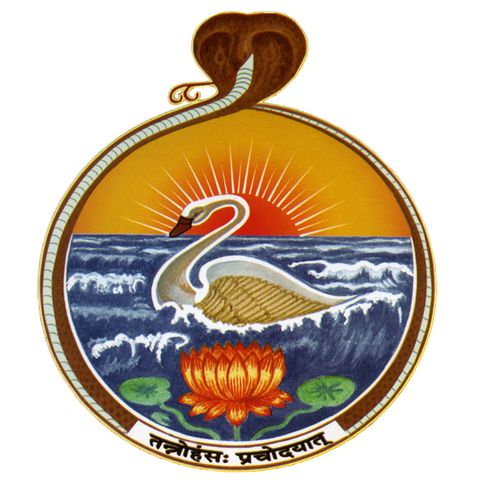South Bay Lecture Series 1 – Vivekachudamani 1 - Three Rare Gifts from God | Swami Tattwamayananda

Scarica e ascolta ovunque
Scarica i tuoi episodi preferiti e goditi l'ascolto, ovunque tu sia! Iscriviti o accedi ora per ascoltare offline.
Descrizione
This lecture was given by Swami Tattwamayananda at Shreemaya Krishnadham on September 14, 2019. Bird’s eye view of Vedanta literature is provided. Vedas constitute the foundation of Vedanta philosophy and...
mostra di piùBird’s eye view of Vedanta literature is provided. Vedas constitute the foundation of Vedanta philosophy and “Sanatana Dharma”.
It is believed that initially, there was only one Veda. Vyasa classified into four groups: Rig Veda, Yajur Veda, Sama Veda and Atharva Veda. Story of Yajnavalkya is discussed in the context of Krishna-Yajur-Veda and Shukla-Yajur-Veda.
Each Veda has 4 divisions: (1) Samhitas (2) Brahmanas (3) Aranyakas and (4) Upanishads. Samhitas are hymns or 'Mantras' to various deities, such as Agni, Indra, Varuna, etc. Brahmanas are explanatory in nature, commentaries on the hymns of the Samhitas or hymns, often describing the performance of rituals. Aranyakas were evolved by hermits living in forest hermitages, belonging to the 'Vanaprastha Ashrama. Upanishads constitute the highest metaphysical and spiritual philosophy, the essence or the conclusions of Vedic thought.
The great Vedic law-giver Manu says that when an householder becomes old, his face is wrinkled, and when his hair becomes grey, - he should retire from all worldly entanglements and live in a hermitage spending his time in contemplation and imparting Vedic wisdom to his pupils.
Sri Shankaracharya holds a pre-eminent position among the world's master-minds and spiritual teachers. 'Viveka-chudamani' is one of his introductory treatises (traditionally called 'prakarana-granthas') on Advaita Vedanta and is usually studied and memorized by students who learn Advaita Vedanta according to the old orthodox tradition. Being an original work of Sri Shankara's genius in 581 verses the book combines a lucid and poetic exposition of the basic tenets of Advaita Vedanta in the form of a lively dialogue between the Guru and the Sishya (disciple) culminating in the highest Advaitic experience of the disciple. The work deals with topics like Value of human birth ( verses: 2,3,4,), qualifications of the disciple and of an ideal teacher (34, 35), the important disciplines to be practiced (16-19), the seven fundamental questions dealing with subjects like bondage, liberation, Atman etc (51), the instruction of the Upanishad Mahavakya "TATTWAMASI" (243-253) etc.
Considered to be an important preparatory text that should be studied and memorized before one steps into the more difficult works like the bhashyas on the "Prasthanatraya", "Viveka-chudamani" is both lucid, simple and exhaustive in its treatment of the fundamental doctrines of Advaita Vedanta.
Shankaracharya’s contributions to Vedanta are discussed. He wrote profound poetry, upacharas and commentary on Bhagavad Gita. Prior to Shankaracharya, Mahavakyas were interpreted as boons from devas. Shankaracharya provided a higher meaning of the Vedas and mahavakyas, that culminates in experience of the Absolute Reality. He traveled all over India, built four monasteries, installed temples and formulated the rituals that are practiced today.
Guru Vandana in Vivekachudamani is discussed. Guru shishya parampara is a unique aspect of Indian culture and is also seen in dance, music and sculpture work. Shankaracharya pays tribute to his Guru, Govinda Bhagvatpada, who is a representation of Brahman and entire Vedic wisdom.
Shankaracharya emphasized that the teachings were not his – they come from Vedas and ancient traditions. Authenticity of Vedas is not dependent on a particular person’s teachings. Each teacher had his own experience of the Truth as proof. Six types of proofs ('pramanas) are discussed.
Human birth, longing for freedom, and the company of great souls are the three rare gifts from God.
Prema, maitri, kripa and upeksha are discussed. A spiritual seeker should be friendly with fellow seekers, have respect towards those more evolved, sympathy towards those less evolved and keep a long distance away from those who may distract him from his spiritual path.
What a wonderful fortune it is to be born as a human being. Human beings alone can throw the light on their own hearts and analyze what is the purpose of human life. Vedanta says: “Death is a comma or a semi-colon, not a full stop”
Even among human beings, not many can ask the higher question: “What is my true nature?”
Nachiketa’s story and his three boons from Kathopanishad are discussed as a representation of spiritual evolution. The three boons that Nachiketa asks are: (1) Let my father not scold me when I return (2) Teach me rituals to get to heaven and (3) Teach me the reality beyond death. Yama then describes life as a journey for highest spiritual enlightenment.
Highest happiness comes when we go beyond happiness and unhappiness, and when we stop looking for happiness all the time.
Seven fundamental disciplines are discussed. (1) Discrimination between unreal and the Real (2) Renunciation of what is unreal (3) Self-control: shama, dama, uparati, titisha, shraddha and samadhana (4) Mumukshutam (5) Shravanam (6) Mananam (7) Nidishyasana
Mumukshutam helps us develop a higher goal. The senses are then withdrawn from their natural focus and redirected towards a higher focus. That automatically give us the first three of the seven disciplines.
Spirituality enables us to have a higher ideal in life and give all our thoughts and actions a healthy direction. When we don’t have any desire for worldly or heavenly enjoyments, then we transcend rituals.
Vedas emphasize experience. Listen and read the scriptures (Shruti); use your own analysis and logic (Yukti); have your own experience – swanubhuti.
Informazioni
| Autore | Vedanta Society, San Francisco |
| Organizzazione | Vedanta Society, San Francisco |
| Sito | - |
| Tag |
Copyright 2024 - Spreaker Inc. an iHeartMedia Company

Commenti